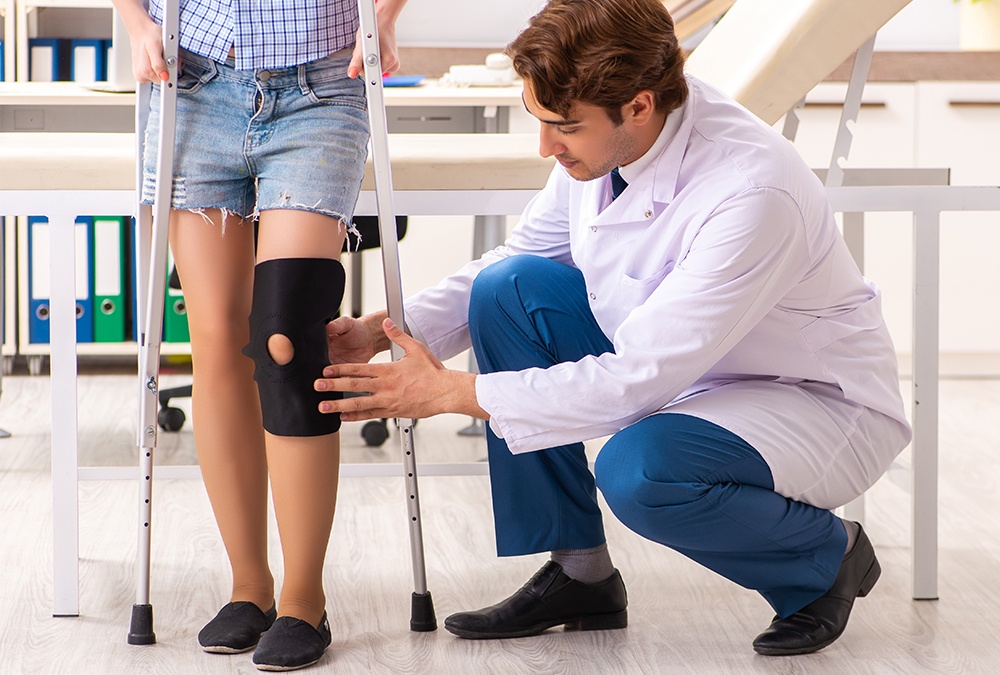Mon - Fri 9.00 - 17.00
Call us +1 (888) 825-9321

A torn ligament in the knee, like an ACL tear, can be both painful and quickly debilitating. It’s such a serious injury that it will most assuredly need medical intervention and treatment, regardless of whether or not surgery is required (and in some case it can be avoided).
The knee’s ligaments are the bands of tissue connecting your leg bones together (your femur, tibia, and fibula). Tears often occur as sports injuries in some of the most active and healthy individuals. This article will explore the types of knee ligament tears often seen in sports medicine, and quickly run through the basic treatment options your doctor may offer in cases of such knee injuries.
The anatomy of the knee includes your thigh bone (femur), shin bone (tibia), outer lower leg bone (fibula), and your kneecap (patella).
What is a ligament? A ligament is a short band of flexible, tough connective tissue that holds two bones together, often forming a joint. Knee ligament injuries can occur in any one of the four major ligaments in your knee. The ligaments in the knee include the following.

The ACL is the most commonly known knee ligament injury, and also the most common in occurrence. This knee ligament runs diagonally through the center of the knee and supports and stabilizes the meeting place of the tibia, femur, and patella (the kneecap). ACL injuries or tears are also called “sprains,” and symptom severity can range anywhere from knee swelling and tenderness, to extreme pain and swelling in cases of complete tears (which will also inhibit movement and cause instability).
The PCL is rarely injured except in incidents of car accidents. It is the ligament that stabilizes the tibia and keeps it from bending too far backwards. The PCL is often damaged due to traumatic injury to the front of the knee, especially if the knees are bent, as when a person is in a seated position in a car. PCL tears can fortunately often heal on their own, but any suspected PCL injury after an accident should be examined and monitored by a medical professional.
The LCL controls the sideways motions of the knee, bracing it against unnatural movements. The LCL connects the femur to the fibula, which is the smaller bone in the lower leg. It’s located on the outer side of the knee next to the tibia (your shin bone). An LCL tear may be marked by pain on the outside of the knee.
The MCL is a broad, thick ligament that runs along the inner part of the knee and connects the femur to the tibia. It can be injured during sporting when there are collisions (as in football), unexpected twists and turns (as in soccer or basketball), and slippages that might occur (think skiing, iceskating). The MCL can also be damaged by repeated overuse, becoming limp in a way that some describe as a worn-out rubber band.
Symptoms of a torn knee ligament may include:
Medical advice should be sought immediately. This is not an injury that will heal all on its own, and a delay in care could cause a worsening of the injury.
The physical exam a doctor gives you to diagnose a torn ligament in your knee may involve draining the swelling of the knee with a needle, ordering X-rays to rule out a broken bone, and/or an MRI to determine the severity of the soft tissue injury.
The first course of action to take is RICE: rest, ice, compression, and elevation. If the tear or sprain is mild enough, this might be your only prescription, to allow your body to heal itself.
The other options outside of surgery are to wear a knee brace as you return to daily activities, take NSAIDS (nonsteroidal anti-inflammatory drugs such as ibuprofen, aspirin, or naproxyn), and get doctor- and/or physical therapist-recommended stretches and strengthening exercises to avoid reinjury in the future.
Possibly yes, possibly no, depending on your injury and your doctor’s guidance. Most LCL and MCL ligament tears will not require surgery, as these are collateral ligament tears. Cruciate ligament tears to the ACL or PCL, however, may need reconstructive knee surgery that splices tendons from different parts of your body, or from a cadaver to replace completely torn or irreparably damaged ligaments.
A ligament reconstruction is a major surgery, and not everyone will want to undergo it (even if it’s needed). If you have knee pain or the injury has compromised your mobility, however, surgical intervention may be desired. Not getting a recommended surgery could lead to lifelong issues of instability and reinjury, so consider your treatment options with your doctor very carefully. Your recovery time will depend on your injury severity and the procedure you undergo.
Knee ligament injury prevention is actually quite difficult, as these tears are unexpected and accidental. However, stretching before physical or sporting activities will help you maintain flexibility, and if you’re working out or starting a new sport, ease in carefully to avoid making any preventable slip-ups.
A torn ligament in your knee is going to be a huge set-back, no matter how bad it is. Hopefully informing yourself of your options and understanding the stakes at play will help you navigate your way to full recovery.
Hello there, I found your website by the use of Google at the same time as looking for a comparable subject, your site came up, it seems great. I have bookmarked it in my google bookmarks.
Thank you!
Thank you!
Very informative. Thank you.
Thanks for reading our blog post!
Thank you!
Thank you!
Thank you!
Thank you!
Thank you,Archie!